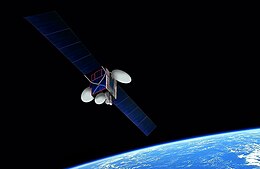Agila 2

Artist impression of ABS-3 in orbit
|
|
| Names | Agila-2 (1997–2009) ABS-5 (2009–2011) ABS-3 (2011–present) |
|---|---|
| Mission type | Communications |
| Operator |
Mabuhay (1997–2009) ABS (2009–present) |
| COSPAR ID | 1997-042A |
| SATCAT no. | 24901 |
| Mission duration | 15 years planned |
| Spacecraft properties | |
| Bus | LS-1300 |
| Manufacturer | Space Systems/Loral |
| Launch mass | 2,820 kilograms (6,220 lb) |
| Start of mission | |
| Launch date | August 19, 1997, 17:50 UTC |
| Rocket | Chang Zheng 3B |
| Launch site | Xichang 2 |
| Orbital parameters | |
| Reference system | Geocentric |
| Regime | Geostationary |
| Semi-major axis | 42,163.82 kilometres (26,199.38 mi) |
| Eccentricity | 0.0004378 |
| Perigee | 35,774 kilometres (22,229 mi) |
| Apogee | 35,811 kilometres (22,252 mi) |
| Inclination | 2.83 degrees |
| Period | 23.93 hours |
| Epoch | July 5, 2014, 07:29:15 UTC |
ABS-3, formerly ABS-5, which was named Mabuhay 1 or Agila 2 after the Philippine eagle, before being acquired by Asia Broadcast Satellite is a communications satellite launched in 1997. It originally provides telecommunications services for the Mabuhay Philippines Satellite Corporation before being sold to ABS in 2009. It was the first Filipino owned space satellite not acquired while in orbit. Another satellite named Mabuhay, previously known as Palapa B-2P, was acquired from Indonesian company Pasifik Satelit Nusantara a year earlier becoming the first satellite owned by a Filipino entity. Built by Space Systems/Loral, the satellite provides the most powerful coverage in the Asia-Pacific region. It covers the entire continent of Asia east of Pakistan, as well as the Western Pacific west of Hawaii. Its control station is located at the Subic Space Center in the Subic Bay Freeport Zone. The spacecraft was launched by the Long March 3B in its first successful flight and currently orbits at 146°E longitude.
ABS Satellite driftedAgila 2 (ABS-5) to the 3°W orbital slot and renamed it ABS-3. It entered service in December 2011 initially as ABS-5. As of June 2014, it remains in service. ABS-3A launched on 1 March 2015 is set to replace ABS-3 which has long exceeded it design life.
It contains 30 C-band transponders at 27 watts and 24 Ku-band transponders at 110 watts, combinable to 12 high-power 220-watt transponders. Total dc power at End of Life (EOL) is expected to be more than 8200 watts. The combination provides a power-to-mass ratio of 5-to-1, making Mabuhay one of the most efficient satellites in the industry. A single Agila 2 satellite transmits more than 190 channels of high-fidelity digital programming to cable companies and home satellite dishes, along with the capability to handle more than 50,000 simultaneous two-way telephone conversations.
...
Wikipedia
